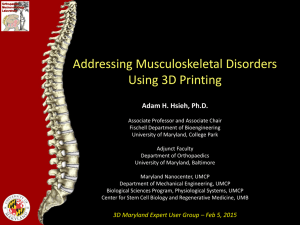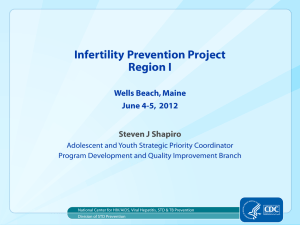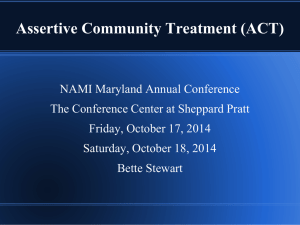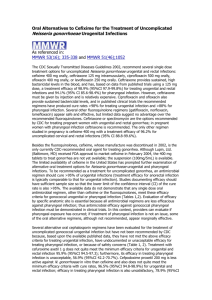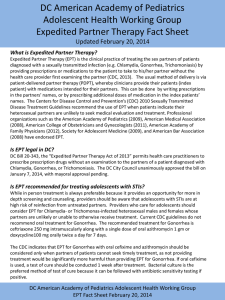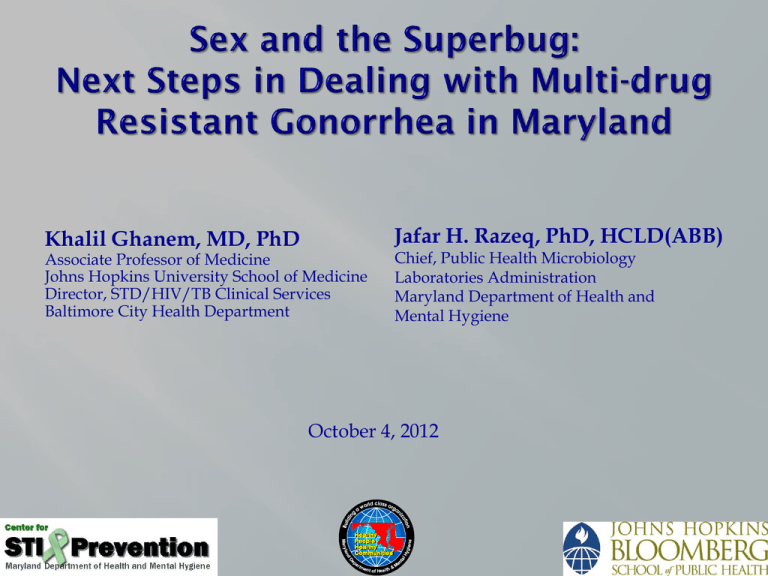
Khalil Ghanem, MD, PhD
Jafar H. Razeq, PhD, HCLD(ABB)
Associate Professor of Medicine
Johns Hopkins University School of Medicine
Director, STD/HIV/TB Clinical Services
Baltimore City Health Department
Chief, Public Health Microbiology
Laboratories Administration
Maryland Department of Health and
Mental Hygiene
October 4, 2012
E-mail your
questions for the
presenters to:
maphtc@jhsph.edu
No relevant financial disclosures
5
6
7
8
Gonorrhea Incidence Rates
in Maryland, 2007-2011
GC Counties
GC MD State
GC US
140
Cases/100,000 Population
120
100
80
60
40
20
0
2007
2008
2009
Year
Source: Center for STI Prevention, Maryland Department of Health and Mental Hygiene
2010
2011
C Peña Jun 2012
Gonorrhea Incidence Rates by Gender
Maryland, 2007-2011
Gonorrhea Incidence Rates by Gender, Maryland 2007-2011
Men Counties
600
Women Counties
Men City
Women City
Cases/100,000 Population
500
400
300
200
100
0
2007
2008
2009
Year
Source: Center for STI Prevention, Maryland Department of Health and Mental Hygiene
2010
2011
CPeña Jul 2012
Gonorrhea by Age (10–25)
Maryland, 2010-2011
Gonorrhea by Age (10-25), Maryland State 2010-2011
800
2010
2011
700
Number of Cases
600
500
400
300
200
100
0
10
11
12
13
14
15
16
17
18
Age
Source: Center for STI Prevention, Maryland Department of Health and Mental Hygiene
19
20
21
22
23
24
25
César Peña, Jul 2012
90
80
70
60
50
Men
40
Women
30
20
10
0
Urethra
Rectum
Gonorrhea
Pharynx
Urethra
Rectum
Chlamydia
Cervix
Any
Herpes
Targeted screening is recommended for high-risk
women (e.g. previous gonorrhea infection, other
STIs, new or multiple sex partners, and
inconsistent condom use; CSW and drug use; area
of high prevalence)
Screening is recommended at the first prenatal
visit for pregnant women who are in a high-risk
group for gonorrhea infection. Those who are at
continued risk, and for those who acquire a new
risk factor, a second screening should be
conducted during the third trimester
Repeat testing (i.e. retesting or rescreening) of GC+
patients recommended 3 months after treatment
The USPSTF found insufficient evidence to
recommend for or against routine screening for
gonorrhea infection in men at increased risk for
infection, but CDC recommends annual gonorrhea
screening for all sexually active MSM by testing for
urethral infection in men who have had insertive
intercourse in past year, rectal infection in men
who have had receptive anal intercourse in past
year, and pharyngeal infection in men who have
had receptive oral intercourse in past year
Repeat testing (i.e. retesting or rescreening) of GC+
patients recommended 3 months after treatment
ORAL SEX
Oral Sex
ANAL SEX
Males
Females
Active Passive Active Passive
Oral
Oral
Oral
Oral
Lifetime
77%
79%
68%
73%
Last sex
27%
28%
19%
28%
Michael RT, et al. Sex in America: A Definitive
Survey.
Little, Brown and Co. UK. 1994
Young MSM: 50%
Young heterosexual
men and women: 1449%
Ekstrand M, et al. AIDS 1999; 13 (12): 1525-33
Halperin D, et al. AIDS Patient Care STDs 1999;
13(12); 717-30
Studies suggest that up to 65% of cases of gonorrhea
and 50% of cases of chlamydia among MSM may be
missed if genital-only testing were performed
Sex Transm Dis. 2008;35(10):845
Clin Infect Dis. 2005;41(1):67
In women, 10% of CT and 31% of GC infections would
have been missed if extragenital testing were not done
Sex Transm Dis. 2011;38(9):783
The majority of rectal and pharyngeal GC & CT
infections are ASYMPTOMATIC
Rectal and pharyngeal infections are of public health
significance
Clin Infect Dis. 2009;49(12):1793
All persons should be tested for rectal and
pharyngeal gonorrhea if they report pharyngeal or
rectal exposures
Sensitivity of culture <50% to detect rectal and
pharyngeal GC vs. >90% sensitivity for Nucleic Acid
Amplification Tests (NAATs) Sex Transm Infect. 2009 Jun;85(3):182-6
The CDC recommends that NAATs be used to detect
these extragenital infections MMWR Recomm Rep. 2011 ;60(1):18
If NAATs for extragenital testing of GC are not
feasible in your setting, use culture to detect these
infections. It is an acceptable alternative
Although none of the NAATs are FDA cleared
to use with extragenital specimens, most large
laboratories have conducted in-house
validation assays and they are able to provide
this service
Check with your local laboratory to see if they
can provide extragenital NAATs testing
See slide on ‘CPT Codes and Laboratory Test
Codes’ at the end of my presentation for
additional details
CEPHALOSPORINS
Ceftriaxone 250mg IM X 1
>98% anogenital
>98% pharyngeal
Cefixime 400mg PO X 1
MACROLIDES
>97% anogenital
90% pharyngeal
Azithromycin 1g PO X 1
97% anogenital
? Pharyngeal
Azithromycin 2g PO X 1*
99% anogenital
99% pharyngeal
* 20% vomiting within 1h
History of Antibiotic Resistance
Unemo M, Shafer WM. Antibiotic resistance in Neisseria gonorrhoeae: origin, evolution, and
lessons learned for the future. Ann N Y Acad Sci. 2011;1230:E19-28
126 GISP isolates with reduced susceptibility to
azithromycin (at MIC ≥2 μg per milliliter) have
been reported in the United States since 2005,
including 27(0.5% of GISP isolates) in 2010
The first strain with high-level resistance to
azithromycin(MIC ≥512 μg per milliliter)
identified in the United States was detected in
Hawaii in 2011 and several strains have now
been detected in Hawaii and California
MMWR;60(18):579-81
Clin Infect Dis 2012; 54:841
Although the MIC breakpoints
for resistance to cephalosporin
have not been defined, the
CLSI defines susceptibility to
cefixime and ceftriaxone as MICs of
0.25 μg per milliliter or below, and
0.125 μg per milliliter or below,
respectively
MMWR 2011 Jul 8;60(26):873-7
N Engl J Med. 2012;366(6):485-7
In November 2011, the Baltimore GISP
Program identified the first cephalosporin
resistant strain.
The Baltimore strain was resistant to cefixime
and cefpodoxime (MIC of 0.5), sensitive to
ceftriaxone (MIC of 0.06) and sensitive to
ciprofloxacin
Combined effects of several
chromosomal mutations:
PenA (PBP2)
PenB (PorB1b)
MtrR (MTRCDE- encoded pump repressor)
Mosaic PenA
Novel mutation resulting in cefixime
resistance
Acquired via horizontal transfer from oral
commensal bacteria
N Engl J Med. 2012;366(6):485-7
• Culture is currently the only reliable method for
determining antibiotic susceptibility
• Maryland is one of the few states that has maintained
culture capacity
GISP analyses are based on (a)
demographic and clinical data
from the first 25-30 male
patients attending the sentinel
clinics each month who have
been identified to have a
positive urethral culture for
N. gonorrhoeae, and (b)
antimicrobial susceptibility
data from these urethral
isolates.
26
First-Line (preferred)
Ceftriaxone 250 mg IM X1 + Azithromycin 1g PO X 1 or
Doxycycline 100mg PO BID X 7 days
Azithromycin is preferred over doxycycline but both are
acceptable
Use dual therapy even if C. trachomatis is ruled out!
Alternate
Cefixime 400mg PO X1 + Azithromycin 1g PO X1 or
Doxycycline 100mg PO BID X 7 days
Azithromycin 2g PO X 1 (single therapy single dose)
Azithromycin 2g PO X1 is the only regimen currently available to treat a
patient who has an allergy to cephalosporins
MMWR 2012 ;61(31):590-4
•
If an alternate regimen is used to treat GC, patient
should return 1 week after treatment for a TEST OF
CURE (culture is preferred but NAAT is also acceptable)
•
If a NAAT is performed as the test of cure and the
follow-up NAAT result is positive, a specimen for
culture should be obtained so that susceptibility testing
can be performed
Culture relevant clinical sites and perform antimicrobial susceptibility
testing using disk diffusion, Etest, or agar dilution
Treat with Ceftriaxone 250 mg IM X 1 PLUS azithromycin 2g orally as a
single dose
TEST OF CURE: culture (≥72 hours after re-treatment), if culture is not
available, with NAAT (≥7 days after re-treatment). If the test of cure NAAT
is positive, a specimen for culture should be obtained to both ensure that
the NAAT result is reliable and to allow for antimicrobial susceptibility
testing
Evaluate sex partners from the preceding 60 days with culture from all
exposed sites and treat with ceftriaxone 250 mg IM X 1 PLUS azithromycin
2g orally as a single dose
•
The laboratory should retain the isolate for possible further testing
MMWR 2012 ;61(31):590-4
Culture relevant clinical specimens and perform
antimicrobial susceptibility testing using disk diffusion,
Etest, or agar dilution
Consult an ID specialist, an STD/HIV Prevention Training
Center (http://www.nnptc.org), or CDC (404-639-8659 )for
treatment advice, and report the case to CDC through the
local or state health department within 24 h of diagnosis
A test-of-cure should be conducted 1 week after retreatment
Evaluate sex partners from the preceding 60 days and treat
with the same antimicrobial regimen with which the index
patient was re-treated
MMWR 2012 ;61(31):590-4
If you suspect treatment failure, assure
treatment for both patient and sex partner(s)
In Maryland, local health departments can
help assure that sex partners of patients with
suspected treatment failure get treated
All Maryland providers are obligated by law
to report all gonococcal infections and
treatment information to local or State health
officials
http://baltimorehealth.org/std.html
http://ideha.dhmh.maryland.gov/SitePages/r
eportable-diseases.aspx
CLINICAL CRITERIA
Patient had laboratoryconfirmed N. gonorrhoeae
infection, and
Patient received CDCrecommended cephalosporinbased antimicrobial regimen
as treatment, and
Patient subsequently had a
positive N. gonorrhoeae test
result (positive culture ≥72
hours after treatment or
positive NAAT ≥7 days after
treatment), and
Patient did not engage in
sexual activity after treatment
LABORATORY CRITERIA
Antimicrobial susceptibility
testing of pre-treatment or
post-treatment isolate of N.
gonorrhoeae demonstrates:
Cefixime MIC ≥0.25 μg/ml,
or
Ceftriaxone MIC ≥0.125
μg/ml
www.cdc.gov/std/treatment/Ceph-R-ResponsePlanJuly30-2012.pdf
33
TEST OF CURE (TOC)
All persons who are treated with
an alternate regimen for GC, or
who have laboratory-evidence of
cephalosporin resistance, or who
are suspected of GC treatment
failure should undergo a TOC
If culture is used for TOC, it can be
done ≥72h after initial therapy
If NAATs are used for TOC, they
can be performed ≥7d after initial
therapy. The possibility of falsepositivity with NAAT as early as 7
days after treatment is a concern,
but is likely to be low*
RESCREENING
The goal of TOC is to rule out
TREATMENT FAILURE
*J Clin Microbiol 2002;40(10):3596-601
All persons who are treated
for gonorrhea, chlamydia, or
trichomoniasis should be
rescreened 3 months after
treatment
For GC, rescreening can be
done with either culture or
NAATs (NAATs are more
sensitive)
The goal of rescreening is to
rule out REINFECTION
At this time, Baltimore City Health Department (BCHD) is
providing EPT services for gonorrhea and chlamydia
EPT may be expanded beyond BCHD in the not too distant future
If a heterosexual partner of a patient cannot be linked to
evaluation and treatment in a timely fashion, then expedited
partner therapy should be considered, using oral combination
antimicrobial therapy for gonorrhea (cefixime 400 mg and
azithromycin 1 g) delivered to the partner by the patient, a disease
investigation specialist, or through a collaborating pharmacy
MMWR 2012 ;61(31):590-4
Emergence of resistance is threatening the viability of EPT for
gonorrhea
Gentamicin
Has been used as first-line treatment in Malawi
during the past 15 years without any observed
emergence of resistance
? Efficacy in pharynx
Carbapenems
Depends on the ceftriaxone resistance mechanisms
and the penA alterations, of which most of them
substantially also affect the carbapenem MICs
CPT Code
LabCorp Test
Code
Quest Test Code
GC Culture
(urethral, cervical,
rectal, pharyngeal)
87081*
008128
480X
Genital: 6916R
Anal: 141275R
Eye: 86421A
GC NAA Genital
87591
183194** (several)
11362X* (several)
GC NAA Rectal
87591
188730
16504X
GC NAA
Pharyngeal
87591
188748
70049X
GC + CT Rectal
NAA
87491 & 87591
188672
16506X
GC+CT
Pharyngeal NAA
87491 & 87591
188698
70051X
*If culture is positive, identification will be performed using separate CPT code(s): 87077 or 87140 or
87143 or 87147 or 87149. Antibiotic susceptibilities are only performed when appropriate (CPT code(s):
87181 or 87184 or 87185 or 87186)
** Several Lab Test Codes exist depending on the specimen source (urethral, urine, cervical)
NAA=nucleic acid amplification test; GC= gonorrhea; CT= chlamydia
250mg, 500mg, 1g, and 2g vials
Stored at 20°C to 25°C (68°F to 77°F) unopened
Once powder is diluted (usually with 1% lidocaine),
may be stored in refrigerator and used within 72 hours
of reconstitution
Cost: $5-$12 for each 250mg dose
Jafar H. Razeq, PhD
Part 2
No relevant financial disclosures
David B. Fankhauser
University of Cincinnati Claremont College
Neisseria gonorrhoeae (NG) is not considered part of human normal
flora and the isolation of this organism is considered to be always
significant.
NG is an exclusive human pathogen.
The organism is fastidious and environmentally sensitive pathogen;
The ideal and best way to recover the organism is to use Dacron or
Rayon swabs to collect patient specimens. Inoculate immediately
onto selective (unexpired) media, incubate at 35-37°C, under 5%
CO2, or transport the inoculated plate in a CO2-generating system at
room temperature.
JCM 1988, 26:54-56 Cotton swabs can be toxic to NG.
Manual of Clinical Microbiology, ASM, 10th ed.
Proper Inoculation and Streaking
“Z” Pattern Primary Inoculation
Cross-Streaked
Proper Inoculation Method
Step 1
Actual Plate
Proper Inoculation and Streaking
Step 2
Ideal Plate
AST is offered at some Private Laboratories
Our Maryland State Public Health Laboratory
is among the few state laboratories in the U.S.
that offers AST for NG
• For disc diffusion: discs containing known amounts of antimicrobial agents
are placed on the surface of an agar plate that has been inoculated with NG
isolated.
• Susceptible isolates usually show inhibition of growth around the disc.
• The E-test is a strip containing a known gradient of an antimicrobial and
calibrated to give results as MIC of that antibiotic.
• The strip is placed on the surface of an agar plate that has been inoculated
with NG.
From 2000 to 2009, more than 11,400 isolates from countries in Latin
America were tested and found:
Ciprofloxacin resistance increased from 2% to 31%
Azithromycin resistance increased from 6% to 23%
Sex Transm Dis. 2012 Oct,39(19):813-821
Results from 17 EU Member States in 2009 showed that 5% of isolates had
decreased susceptibility to cefixime, an upward trend in the minimum
inhibitory concentrations of ceftriaxone and a high prevalence of resistance
to ciprofloxacin (63%) and azithromycin (13%).
The European gonococcal antimicrobial survelliance programme, 2009.
Emergence of high-level azithromycin resistance in N. gonorrhoeae in
England and Wales.
The 2009 study showed a major shift in six isolates recovered from patients
attending STI clinics with azithromycin MICs of > 256 mg/L.
J. Antimicrob Chemother 2009; 64, 353-358
The proportion of N. gonorrhoeae isolates with decreased susceptibility and
resistance to cefixime and ceftriaxone have increased over the years in
Sweden.
All available Swedish isolates (331) from 1998-2009 were tested and results
showed that 9.1% of the isolates displayed resistance to cefixime, and 0.3%
resistance to ceftriaxone.
Sex Transm Infect 2010; 86:454-460
USA % Resistant
2009
2010
Penicillin
3.8
3.5
Tetracycline
7.9
9.4
Ciprofloxacin
2.1
2.9
For Cefixime and Ceftriaxone:
• An average of 5,865 isolates tested annually during 2000-2010
• The percentage of isolates with an MIC of > 0.25 µg/ml for cefixime increased
from 0.2% in 2000 to 1.4% in 2010
• The percentage of isolates with an MIC of > 0.125 µg/ml for ceftriaxone
increased from 0.1% in 2000 to 0.3% in 2010
MD % Resistant
2009
2010
Penicillin
3
6
Tetracycline
20
27
Ciprofloxacin
5.4
4
Azithromycin:
5 isolates have been detected with an MIC of > 1.0 µg/ml
CDC recommends that State and local health
departments should promote maintenance of
laboratory capacity to culture NG to allow
antimicrobial susceptibility testing of isolates
for cephalosporin resistance
`
CDC/MMWR July 8, 2011/(60), 26:873-877
The capacity of laboratories in the United States to isolate NG by
culture is declining rapidly because of the widespread use of
NAATs for gonorrhea diagnosis.
It is essential that culture capacity for NG be maintained to
monitor antimicrobial resistance trends and determine
susceptibility to guide treatment following treatment failure.
Laboratories must maintain culture capacity or develop
partnerships with laboratories that can perform culture.
Update to CDC's Sexually Transmitted Diseases Treatment Guidelines, 2010: Oral Cephalosporins No Longer a
Recommended Treatment for Gonococcal Infections. MMWR August 10, 2012 / 61(31);590-594.
To help control gonorrhea in the United States, healthcare providers must maintain the ability to collect
specimens for culture and be knowledgeable of
laboratories to which they can send specimens for
culture.
Update to CDC's Sexually Transmitted Diseases Treatment Guidelines, 2010: Oral Cephalosporins No Longer a
Recommended Treatment for Gonococcal Infections. MMWR August 10, 2012 / 61(31);590-594.
Health-care systems and health departments must
support access to culture.
Update to CDC's Sexually Transmitted Diseases Treatment Guidelines, 2010: Oral Cephalosporins No Longer a
Recommended Treatment for Gonococcal Infections. MMWR August 10, 2012 / 61(31);590-594.
IF NOT, then we will go from
Resistant NG and Multi-Drug Resistant NG
TO
Extensively-Drug-resistant NG
Pan/Totally Drug-Resistant NG
Untreatable NG!
“It is probably only a matter of time before extensively drug-resistant N.
gonorrhoeae strains become widespread and treatment failures,
particularly for pharyngeal gonorrhoea, become commonplace.”
“Action is therefore urgently needed at local and international levels to
combat the problem. We advise that government agencies take this threat
seriously and provide urgently needed funds for increased research,
surveillance activities and vaccine development.”
Whiley DM, Goire N, Lahra MM, et al. The ticking time bomb: escalating antibiotic resistance in Neisseria
gonorrhoeae is a public health disaster in waiting. J Antimicrob Chemother 2012; 67: 2059-2061.
Maryland Department of Health and Mental Hygiene
Prevention and Health Promotion Administration
Center for Sexually Transmitted Infection Prevention
410-767-6690
http://ideha.maryland.gov/OIDPCS/CSTIP/SitePages/cstip-forhealthcare-providers.aspx
Division of Infectious Disease Surveillance
Center for Surveillance, Infection Prevention and Outbreak Response
410-767-6700
http://ideha.maryland.gov/SitePages/reportable-diseases.aspx
Laboratories Administration
Division of Public Health Microbiology
http://dhmh.maryland.gov/laboratories/SitePages/micro.aspx
E-mail questions for
the presenters to:
maphtc@jhsph.edu

